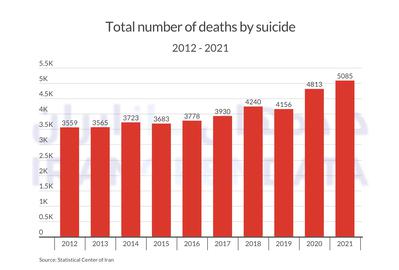Iranwire – The number of suicide deaths has grown by more than 40 percent in Iran over a decade, according to officials statistics, as the Iranian people faced deepening economic, political and social upheaval.

The 2022 report on “Social Justice Indicators” shows that law enforcement agencies recorded 5,085 suicide cases in 2021, compared to 3,559 in 2011, the collaborative initiative Iran Open Data said in a recent article.
Over 40,000 people died by suicide between 2011 and 2021, more than twice the total number of murders recorded during the decade.
Law enforcement agency data shows a significant number of deaths listed under the title “other suspicious deaths,” without further description, Iran Open Data noted, adding that the number of these deaths is about six times the total number of suicides and 12 times the number of murders.
Apart from the police, two other institutions, the Forensic Medicine Organization and the Ministry of Health, provide scattered statistics on suicide, but this information is not publicly available and the figures published on local media show discrepancies, according to Iran Open Data.
In 2021, the Forensic Medicine Organization reported 5,143 deaths by suicide in 2019, according to the ISNA news portal. This figure is almost 20 percent higher than the number of suicides reported by the police.
Provincial Disparities
According to police statistics, an average of 4,183 people died by suicide every year between 2011 and 2021, which suggests a suicide mortality rate of 5.1 per 100,000 people, Iran Open Data said.
Suicide cases were not evenly distributed across Iran. Analysis of regional data shows that the suicide rate is higher in the western provinces compared to the central, northern, southern and eastern regions.
The suicide rate was 11.8 per 100,000 people in Kermanshah, 11.5 in Ilam and 10.5 in Kohgiluyeh and Boyer-Ahmad, more than twice the national average.
Iran Open Data pointed out that Iran’s western regions have a more fragile economy, and are poorer than other parts of the country. However, these factors don’t appear to have affected the suicide rates in the eastern provinces of Sistan and Baluchestan and South Khorasan, which are also among the country’s poorest regions.
***
Iran Open Data’s original article in Persian is available here.
Founded in 2016, Iran Open Data (IOD) strives to make Iran’s official data accessible, available and re-usable. Not only does IOD collect and process raw datasets for researchers and experts, it also publishes exclusive data-driven articles and digital stories for the general public. Additionally, IOD conducts public data calls and surveys on often neglected or taboo issues that are rarely addressed by the government. Follow IOD for all the data-stories concerning Iran.
 Shabtabnews In this dark night, I have lost my way – Arise from a corner, oh you the star of guidance.
Shabtabnews In this dark night, I have lost my way – Arise from a corner, oh you the star of guidance.



